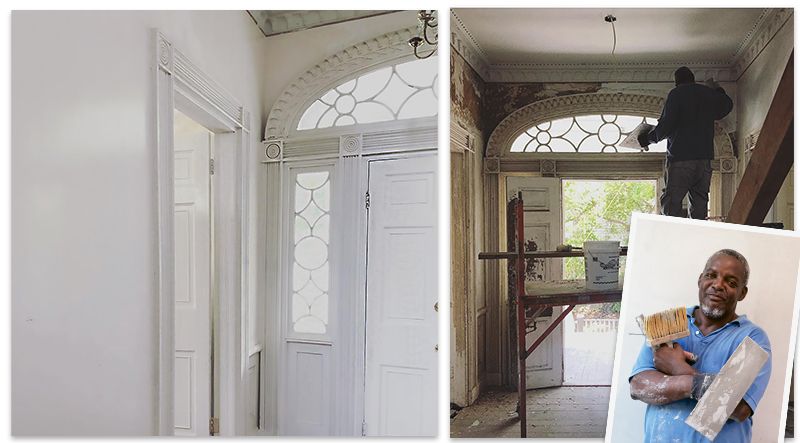Terry Jenkins’s plasterwork is a lesson in preservation

Terry Jenkins repairing the plasterwork on the entryway of a home
In a city filled with buildings that date as far back as the early 1700s, repairs and renovations are never-ending. It takes teams of people to keep details like Flemish bond brickwork, Palladian windows, and hood mouldings intact. And then there’s the plasterwork. When cornices, cast medallions, trim, and walls begin to fail, it’s often Terry Jenkins, master plasterer and owner of Jenkins Stucco and Plaster, who gets called.
For his lifetime of work with the soft mixture of lime, gypsum, sand, and water, the 55-year-old received the Samuel Gaillard Stoney Conservation Craftsmanship Award from the Historic Charleston Foundation (HCF) in April. “Craftsmen like Terry are essential to the culture of preservation and stewardship,” says Katherine Pemberton, HCF manager of Research & Education.
Jenkins can still vividly recall how he got his early introduction into the craft. At age 16, he was having problems in school and looking to quit. Luckily, his older brother stepped in to recommend Jenkins join the Job Corps—a vocational training program through the Department of Labor. “My brother told me, ‘Take up plastering—it’ll be around here the rest of your life. You’ll always have a job.’ I thank him for that. He was right.”
Jenkins’s work can be found in homes such as 53 Elizabeth Street, 25 Legare Street, and 48 South Battery—a project he won’t soon forget.
“It was torn up real bad,” remembers Jenkins, who found the walls and ceiling of the James Macbeth House (c. 1846) in tatters. Because of the home’s unique Greek Revival architecture, the building crew had to run the ductwork across the wall inside a hallway, then frame around it. “I had to plaster the ductwork so it wouldn’t show,” says Jenkins. “Even as I put on the scratch coat, brown coat, and the white coat, I didn’t know what the outcome would be.” But if you look at the hallway today, you’d never know the duct system was there. The humble artisan says it’s all in a day’s work: “I’ve been doing this so long, it just comes natural.”
---------
Master Plaster - Jenkins’s tricks of the trade
Lookout for Leaks
Make sure your home doesn’t have any kind of leaks where water can reach the plaster. Plaster holds water which causes cement on the outside to dry up. If you don’t have any leaks, your plaster should last forever.
Check the Temp
Temperature only plays a role during the winter. Extreme cold can freeze any moisture in the plaster and then after so many days, it warms, which causes cracking. If you want to repair a wall during the winter, make sure the heat is on and the wall stays warm.
Check annually
If you see a crack forming, have it checked. The best way to check plaster on the inside of the house is to tap on the wall. If you hear a solid sound, everything is fine. If you hear a hollow sound, then your walls are likely starting to come loose and materials are losing their hold.
Photographs by (Jenkins) Lizzy Smith & Courtesy of (Jenkins & Entrance) Historic Charleston Foundation